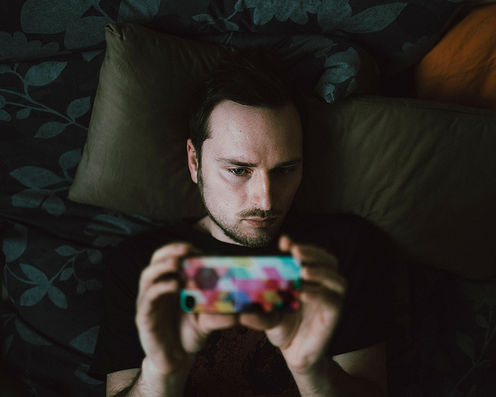
We all suffer from too little sleep from time to time, some more than others. There are many possible reasons, depending on our age, genes and sleep habits; but another possible culprit is using technology before going to sleep.
A 2011 survey found nine in ten people use some form of electronics in the hour before bed. This ranges from playing video games and watching television, to using light-emitting e-readers, tablets and smartphones.
While many of these devices, especially light-emitting e-readers, seem harmless enough, the light they emit may affect our sleep patterns and leave us feeling tired the next day.
How does light affect sleep?
Light exposure can directly influence sleep and the timing of sleep by acting on our circadian timing system, also know as the body clock. Indeed, light is often used to overcome jet lag and can help shift workers adapt to their work schedule.
One way light exposure may impact sleep and our circadian timing system is by affecting the production of melatonin during the night. Melatonin is a “sleep” hormone produced by the pineal gland in the brain.

Melatonin levels begin to increase around two hours before bed (around 9pm for someone who usually goes to bed around 11pm) to help initiate sleep. These levels remain high during sleep, before starting to decrease shortly prior to waking.
Exposure to light during the evening hours can inhibit the production of melatonin, so that melatonin production is shifted to later in the night. Using the example above, melatonin levels may only start to increase around 10pm, which may delay your sleep until around midnight.
What does the research say?
A study published recently in the Proceedings of the National Academy of Science shows just how much light-emitting electronic devices may affect sleep.
In this study, a group of 12 healthy adults lived in a controlled environment for two weeks. All individuals tested two conditions: reading from a light-emitting e-book and reading from a printed book in a dim room prior to going to sleep.
Researchers measured participants’ sleep, plasma melatonin levels, and subjective sleepiness and objective alertness during the evening and the morning.
Not surprisingly, researchers found that using an e-book in the evening suppressed melatonin levels by more than 50%. To compare, in the printed book condition there was no suppression of evening melatonin.
On the night following the e-book condition, participants’ dim light melatonin onset (when the body starts producing melatonin during dim light conditions) occurred more than 1.5 hours later than when participants read the printed book.
The study also showed that participants took nearly ten minutes longer to fall asleep and had less REM sleep in the e-book condition compared to the printed book condition.

Participants also reported feeling less sleepy and were more alert in the evening in the e-book condition compared with the printed book.
This was the reverse in the morning with participants reporting feeling sleepier when they had been reading from the e-book the previous night. Not only did participants wake feeling sleepier, but it took them longer to “wake-up” and attain the same level of alertness as the printed book condition.
Given that participants were simply reading, an activity most people would classify as relaxing, the fact that the e-book has an alerting effect shows just how much light alone can influence sleep and sleepiness. Indeed, previous research has shown that bright light exposure can have an alerting effect.
Activities such as playing a game, sending text messages or even checking emails, which may also have an alerting effect, may have an even greater effect on sleepiness and alertness in the evening. This may make it harder to “unwind” before sleep and may delay sleep time further.
All of the above findings have a similar theme: a delay in melatonin, reduced sleepiness in the evening, and a longer time to fall asleep, all result in a later sleep time. As most people need to wake at a similar time each day, this then results in a decreased sleep duration and increased difficulty in getting up in the morning.

In the long term, this may also lead to more serious conditions such as sleep onset insomnia, delayed sleep-phase disorder (where your body wants to go to sleep and wake up later) and chronic sleep deficiency.
These issues may be more prominent in young adults, adolescents, and children who are more likely to use electronics in the hours before bedtime.
So what can we do?
The most obvious thing to do is to reduce the use of light-emitting electronic devices prior to bedtime, or at least within the hour before sleep.
For adolescents and adults who are more reluctant to stop using electronic devices, there are some applications that can alter the amount of blue light that is emitted. Blue light suppresses melatonin production and can directly impact sleep, so reducing the amount of exposure in the evenings may help to allay the negative effects of light on sleep.
But it’s probably not a good idea to rely on these applications too heavily, as the possible benefits or effects on sleep have not been investigated.
My advice would be to buy a book or opt for an e-reader that doesn’t emit light. Try to reduce the amount of light you are exposed to in the evenings. Who knows, you may even find it more relaxing!
Gemma Paech does not work for, consult to, own shares in or receive funding from any company or organisation that would benefit from this article, and has no relevant affiliations.
